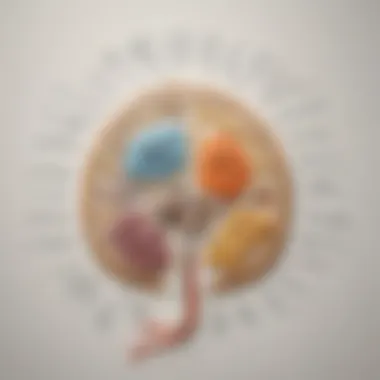Navigating Teenage Depression and Eating Disorders


Intro
Teenage years are often seen as a time of exploration, growth, and self-discovery. However, for some adolescents, this period is also marked by severe psychological challenges. Among these are teenage depression and eating disorders, which frequently occur together. These two issues are deeply intertwined, each influencing the other in significant ways. Understanding this intersection is crucial for effective treatment and support.
The prevalence of teenage depression has increased over recent years, coinciding with a rising number of eating disorders among adolescents. Understanding this relationship can shed light on the underlying factors that contribute to both conditions. This article aims to dissect this complex interplay, offering a comprehensive guide for students, researchers, educators, and professionals.
Through exploring the symptoms, risk factors, and necessary support systems, we hope to bring attention to the urgent need for early intervention. The insights gathered here could enhance the knowledge base for effective treatment strategies, aiming for recovery and better mental health outcomes in adolescents.
Prelude to Teenage Mental Health Issues
Teenage mental health is a pressing issue that requires urgent attention. Understanding the complexities surrounding this topic is essential for educators, parents, and professionals working with adolescents. Mental health issues during teenage years can manifest in various ways, leading to significant challenges for young individuals.
The importance of this subject lies in its impact on overall youth development. Often, teens experience a whirlwind of emotions that are difficult to manage. These struggles can lead to disorders such as depression and eating disorders, which are alarmingly prevalent in contemporary society. Addressing these issues is crucial not only for the well-being of the individual but also for the stability of families and communities.
Furthermore, recognizing the early signs of mental health issues can facilitate interventions that improve life outcomes for affected youth. The earlier these issues are identified, the more effective the treatment can be. Awareness and education about mental health can promote healthier coping mechanisms among teenagers, reducing the risk of developing severe conditions.
In this article, we aim to delve into multiple facets of teenage mental health, particularly focusing on the link between depression and eating disorders. This discussion is relevant because of the increasing rates of these issues, which often coexist and influence each other negatively. By understanding these factors, we can foster a more supportive environment for teens navigating through their formative years.
"Understanding mental health in teenagers is not just about recognizing problems; it is about empowering them with knowledge, resources, and support."
By establishing a nuanced understanding of teenage mental health issues, we hope to equip our readership with insights and strategies that can lead to effective solutions for today’s youth.
Defining Teenage Depression
Defining teenage depression is crucial for understanding its profound impacts on adolescents and their surrounding environment. Recognizing this condition allows for better identification and timely intervention. Depression in teenagers often presents differently than in adults, leading to misdiagnosis or delayed treatment. Such nuances make it essential to establish clear clinical definitions and attributes specific to the adolescent demographic.
The complexity of teenage depression arises from various factors, such as hormonal changes, social pressures, and developing identities. By defining this condition, we can decode its clinical characteristics, recognize its prevalence, and appreciate how it intersects with phenomena like eating disorders. Further, understanding depression provides a foundation for addressing the risk factors and implications that affect not only the individual but also their families and communities.
Clinical Characteristics of Depression in Adolescents
Teenage depression manifests through an array of symptoms that may differ from one individual to another. Key clinical characteristics include:
- Persistent Sadness: Many teenagers experience a lingering sense of sadness or hopelessness that does not seem to ebb.
- Irritability: Increased irritability is common, often mistaken for typical teenage angst.
- Social Withdrawal: A tendency to isolate oneself from friends and family is another characteristic that surfaces.
- Changes in School Performance: This can involve a sudden drop in grades or loss of interest in academic activities.
- Physical Complaints: Persistent headaches or gastrointestinal issues often lack a medical basis, leading to further confusion.
Identifying these symptoms is important for parents, educators, and professionals alike. Early intervention based on these clinical characteristics can lead to more effective support for the affected adolescents.
Prevalence Rates of Depression in Teenagers
Studies indicate that teenage depression is alarmingly prevalent, affecting millions of adolescents globally. Approximately 20% of teenagers experience at least one episode of major depression before reaching adulthood. Factors contributing to this surge include increased academic pressures, the influence of social media, and heightened awareness of mental health issues.
- Demographic Disparities: While depression affects all teenagers, research suggests it is more prevalent among female adolescents compared to their male peers. This difference may stem from various psychosocial factors.
- Cultural Influences: Societal expectations and cultural values play significant roles in the expression and recognition of depressive symptoms.
Understanding the prevalence of teenage depression is key to addressing mental health in young people today. It informs the development of programs and supports tailored to the unique needs of adolescents. Recognizing these rates helps mitigate stigma and emphasizes the urgency for effective treatment options.
Understanding Eating Disorders
Understanding eating disorders is essential in the context of teenage mental health. These disorders can serve as coping mechanisms for the emotional pain often associated with depression. Adolescents may use food-related behaviors to exert control in an otherwise chaotic emotional landscape, thereby linking their mental health to their eating behaviors. Knowledge about eating disorders not only helps in identifying these conditions but also draws attention to their significance in the interplay with depression. This dual understanding can improve outcomes through timely intervention by parents, teachers, and healthcare providers.
Types of Eating Disorders Common Among Teens
Anorexia Nervosa
Anorexia Nervosa is a serious eating disorder characterized by an intense fear of gaining weight and a distorted body image. It contributes to the overall topic as it demonstrates how eating disorders can manifest through extreme behaviors such as drastic weight loss and restrictive eating. A key characteristic of Anorexia Nervosa is the pursuit of thinness, which often leads to severe physical health issues. By understanding this disorder, one can grasp how it amplifies feelings of inadequacy and helplessness often seen in depressive states. The uniqueness of Anorexia lies in its potential to cause a variety of complications, from nutritional deficiencies to psychological issues, further complicating the recovery process.
Bulimia Nervosa


Bulimia Nervosa is marked by cycles of binge eating followed by compensatory behaviors such as purging. This eating disorder's contribution to the topic is crucial as it reflects a different coping mechanism for emotional distress compared to Anorexia. The key characteristic here is the pattern of behavior which tries to conceal the disorder. Bulimia is particularly relevant because it can often go unnoticed, posing challenges for early diagnosis. Its unique feature lies in the resulting physical and emotional toll, leading to further depressive symptoms and an increased risk of self-harm.
Binge Eating Disorder
Binge Eating Disorder involves frequent episodes of consuming large amounts of food accompanied by feelings of loss of control. This disorder is significant because it links emotional distress directly with food consumption without the purging behaviors seen in Bulimia. A prominent characteristic is the emotional engagement during binges, often provoked by stress, loneliness, or sadness. Its uniqueness comes from its prevalent nature among adolescents who face substantial societal pressure, contributing to both depression and unhealthy eating habits. Recognizing the signs behind Binge Eating Disorder can facilitate tailored interventions to address both mental health and physical health.
Signs and Symptoms of Eating Disorders
The signs and symptoms of eating disorders can vary across different types but often include:
- Preoccupation with food: Constant thoughts about food, dieting, or weight loss.
- Significant weight changes: Notable fluctuations in weight, whether loss or gain.
- Emotional distress: Feelings of anxiety or depression that may rise around meals.
- Physical symptoms: Issues such as fatigue, gastrointestinal problems, or dizziness.
Recognizing these signs early is critical for effective intervention. Discussions around eating disorders need to encompass educational elements that can identify a troubling of behavior patterns, providing a clearer path towards recovery.
The Interconnectedness of Depression and Eating Disorders
The relationship between teenage depression and eating disorders is complex and multifaceted. Understanding this interconnectedness is crucial for parents, educators, and mental health professionals. Both conditions can significantly impact a teenager’s life, leading to severe consequences if left unaddressed. Awareness of the relationship aids in developing effective prevention and intervention strategies. Furthermore, this understanding underlines the importance of early detection and comprehensive treatment plans that address both mental health and nutritional needs. Overall, fostering a holistic perspective allows for better support structures that can facilitate recovery for adolescents experiencing these issues.
Statistical Correlation Between Conditions
Research indicates a strong correlation between teenage depression and eating disorders. Studies show that a significant percentage of adolescents with eating disorders also exhibit signs of depression. For instance, around 30% of individuals with anorexia nervosa also experience major depressive disorder. Bulimia nervosa similarly shows high comorbidity with depression, often exacerbating the severity of both conditions. This statistic underscores the importance of treating these disorders as interconnected rather than in isolation. A linked approach to treatment may enhance outcomes, as understanding the overlap can lead to more effective therapeutic interventions.
Psychological Factors Linking Depression and Eating Disorders
Several psychological factors contribute to the link between teenage depression and eating disorders. Low self-esteem, negative body image, and feelings of inadequacy are common among teens facing both challenges. These factors can create a vicious cycle. Adolescents may turn to disordered eating as a way to cope with their depressive symptoms, seeking control over their bodies when they feel powerless in other aspects of their lives. Additionally, cultural pressures regarding appearance and weight can further exacerbate feelings of depression.
Factors influencing this relationship include:
- Negative self-perception: Many adolescents grapple with societal standards regarding beauty and body image. This can lead to feelings of worthlessness, fueling both depression and disordered eating.
- Coping mechanisms: For some teens, controlling food intake becomes a maladaptive method for dealing with emotional distress. This relationship highlights the need for mental health support that addresses both conditions.
- Stress and trauma: Adolescents facing traumatic experiences, such as bullying or family issues, are at higher risk for developing both eating disorders and depression. The emotional toll of these experiences can lead to unhealthy coping strategies involving food.
Understanding these psychological connections is essential for early intervention. Therapeutic strategies focusing on self-esteem improvement and body positivity can be effective in breaking the cycle of depression and eating disorders. As we continue exploring interventions and support mechanisms, it becomes clear that an integrated approach is vital to recovery.
Risk Factors for Developing Depression and Eating Disorders
Understanding the risk factors for developing teenage depression and eating disorders is crucial in grasping the broader issues surrounding teenagers' mental health. These factors can significantly influence the onset and progression of these conditions. By dissecting both genetic and environmental influences, we unveil the complexities involved.
Genetic predispositions can set the stage for vulnerabilities. If a family has a history of mental health disorders, the risk for teenagers may increase. Biological factors, such as hormonal changes during adolescence, also contribute to the mental health landscape. These elements are not solely responsible but act as a foundation upon which other experiences build.
Environmental and social factors are equally significant. Teenagers are often exposed to societal pressures that can exacerbate feelings of inadequacy and trigger eating disorders. The role of peer influences, family dynamics, and societal expectations can stir a cocktail of emotions leading to mental health struggles. Addressing these risk factors can lead to better preventive measures and help in managing existing conditions effectively.
Genetic and Biological Influences
Genetic and biological influences play a pivotal role in the development of depression and eating disorders during the teenage years. Certain genes may predispose individuals to mood disorders, affecting their mental health regulation. Studies have shown higher concordance rates of these conditions among identical twins, indicating genetic factors' impact.
Additionally, adolescence is marked by significant hormonal shifts. These fluctuations can affect neurotransmitter levels in the brain, directly influencing mood and appetite. For example, serotonin, a key neurotransmitter linked to mood regulation, can disrupt normal functioning during this tumultuous stage. Teens may become more susceptible to emotional disturbances and the subsequent development of eating disorders as a coping mechanism for underlying depression.
Environmental and Social Influences
The environment in which a teenager develops has profound implications on their mental health. Social structures, such as familial relationships and peer groups, significantly shape their self-esteem and identity. Family history of mental illness, particularly in parents or siblings, can create an atmosphere of anxiety and distress, increasing vulnerability.
Peer pressure and societal standards also cannot be understated. In today’s digital age, the images presented through social media can skew perceptions of body image and success. Teens often feel the need to conform to unrealistic ideals, leading to unhealthy eating practices and depressive symptoms.
Other environmental influences include experiences of bullying or social isolation. This sense of exclusion can compound feelings of worthlessness, which are pivotal in both depression and eating disorders. Creating supportive and understanding environments is essential for mitigating these risks.
"Identifying and addressing the root causes, whether genetic or environmental, is key to helping teenagers navigate through their mental health challenges."
Ultimately, understanding the interplay of these risk factors lays a foundation for effective strategies to prevent and treat depression and eating disorders, ensuring that teenagers receive the support they need during critical developmental stages.


Impact of Teenage Depression and Eating Disorders on Daily Life
Understanding the impact of teenage depression and eating disorders on daily life is crucial for grasping how these issues affect adolescents in profound ways. Such conditions do not simply exist in isolation; they intertwine and manifest in multiple aspects of a teenager's existence. Academic performance, social interaction, and emotional well-being all suffer due to these interrelated challenges.
The significance of this understanding lies not only in the recognition of the problem but also in tailoring interventions that can effectively address the needs of affected individuals. When teenagers are grappling with depression or disordered eating, they may struggle with motivation, focus, and the basic functionality required to navigate daily tasks. Thus, exploring the impact of these conditions offers valuable insight into the ripple effects on young people's lives.
Effects on Academic Performance
Teenage depression and eating disorders can severely hinder academic performance. Many teenagers experiencing these conditions may find it difficult to concentrate during classes or complete assignments on time. The lack of energy and motivation, alongside cognitive impairments associated with depression, can lead to declining grades. Furthermore, when eating disorders are involved, the psychological stress can further distract from academic responsibilities.
The consequences can be dire for a teenager’s future. Poor academic performance can limit educational opportunities and affect career choices down the line.
Research indicates that students with eating disorders often experience higher rates of absenteeism. They may miss crucial instructional days due to physical health complications or accompanying mental health challenges. This absenteeism can result in substantial gaps in learning, making it even harder to catch up once they return to school.
"Effective interventions that address mental health can significantly improve not only emotional well-being but also academic success for affected teens."
Social Implications and Isolation
The social implications of teenage depression and eating disorders are equally concerning. Adolescents are in a critical phase of their social development. When grappling with these conditions, many teens may withdraw from friendships and social activities. The feelings of shame, inadequacy, or fear of judgment may lead them to isolate themselves, creating a cycle that exacerbates their mental health issues.
Isolation can foster a sense of loneliness that deepens depressive feelings. The social skills that typically develop during teenage years may stagnate or deteriorate, leaving affected individuals feeling unprepared for adult social interactions. As a result, they may struggle to form or maintain healthy relationships, which is crucial for emotional health.
Additionally, those struggling with both depression and an eating disorder might face bullying or stigmatization from peers, further compounding feelings of worthlessness and alienation. This isolation does not only affect their current relationships but can have lasting effects on their capacity to connect authentically with others later in life.
In summary, understanding the impact of teenage depression and eating disorders on daily life reveals significant areas that require attention. By recognizing how these conditions influence academic performance and social engagement, families, educators, and mental health professionals can implement effective strategies to support recovery and promote resilience among adolescents.
The Role of Family in Managing Teenage Depression and Eating Disorders
Familial involvement is crucial when addressing the complexities of teenage depression and eating disorders. Family members can serve as the primary support system, which can significantly influence recovery trajectories. Understanding the roles that family dynamics play is integral to creating comprehensive management strategies for these conditions.
Families are often the first line of defense in identifying issues related to mental health and disordered eating. Those living with teenagers may notice subtle changes in behavior, mood, and eating habits. An early detection can lead to timely intervention, possibly averting the escalation of these conditions. Families can also foster an environment of open dialogue, encouraging the adolescent to express feelings and concerns. A supportive family may help reduce the stigma surrounding mental health challenges, making treatment more accessible to the teenager.
Identifying Signs Early
Recognizing the signs of depression and eating disorders is essential for family members. The earlier these issues are identified, the better the chances for effective treatment. Common warning signs tied to teenage depression include significant mood swings, withdrawal from friends or family, and alterations in sleeping or eating patterns.
In contrast, signs of eating disorders like anorexia nervosa or bulimia may be more visible through extreme weight loss, unusual food rituals, or secretive behaviors surrounding meals. Family members can benefit from being educated on these signs:
- Behavioral Changes: Sudden shifts in demeanor, lack of energy, or irritability.
- Physical Signs: Noticeable weight changes, fatigue, or poor personal hygiene.
- Emotional Indicators: Feelings of worthlessness or extreme dissatisfaction with body image.
Communicating concerns may initially invoke resistance. However, it is essential for family members to approach the situation with compassion and understanding.
Providing Support and Communication
Effective communication is the cornerstone of familial support. Teens need to know that their families are there for them without judgment. Open conversations can create a safe space for adolescents to divulge their feelings and thoughts. Family members should aim to convey understanding and empathy.
Some practical ways families can nurture this supportive environment include:
- Active Listening: Pay attention and validate feelings without interruption.
- Regular Check-ins: Consistently engage in discussions about wellbeing, fostering a culture where mental health is openly discussed.
- Encouraging Professional Help: Support choices to seek therapy or counseling, emphasizing that professional guidance is a sign of strength and not weakness.
- Participating Together: Taking part in family activities that promote bonding, such as cooking healthy meals or engaging in exercise, can help create positive reinforcement towards recovery.
The role of family cannot be underestimated in the management of teenage depression and eating disorders. Their support can often mean the difference between overcoming these challenges and struggling in silence.
Recognizing the interplay between family dynamics and mental health can pave the way for educational programs aimed at equipping families with the tools to help their teens. Understanding how to identify warning signs and communicate effectively is a vital step toward fostering a healthier environment for adolescents.
Professional Treatment Options
When addressing teenage depression and eating disorders, professional treatment options are crucial. These conditions often coexist, creating a complex landscape that requires specialized interventions. Effective treatment plans incorporate various methods, such as psychological therapies and nutritional guidance.


Psychological Therapies
Cognitive Behavioral Therapy
Cognitive Behavioral Therapy (CBT) is a cornerstone of treatment for many mental health issues, including depression and eating disorders. This therapy focuses on identifying and changing negative thought patterns. Key characteristic of CBT is its structured approach, which helps adolescents learn coping mechanisms and better handle distressing emotions.
One of the essential benefits of CBT is its adaptability. It can be tailored to fit individual needs and specific disorders. In the context of teenage depression and eating disorders, CBT helps individuals recognize unhealthy behaviors and thoughts related to food and body image.
However, the effectiveness of CBT can vary among teens. Some may need additional support for deeper emotional issues that CBT alone might not address. Nonetheless, its practical, goal-oriented nature makes it a frequently recommended option in therapy settings.
Dialectical Behavior Therapy
Dialectical Behavior Therapy (DBT) presents another effective strategy for treating these issues. It is particularly beneficial for adolescents who experience intense emotions and struggle with self-harm, common in both depression and eating disorders. One strong feature of DBT is its emphasis on mindfulness, which aids teens in becoming more aware of their thoughts and feelings.
DBT combines individual therapy with skills training groups. This approach helps individuals develop essential skills like emotion regulation and interpersonal effectiveness. This structure supports the goal of enhancing emotional stability, making it a suitable choice for addressing overlapping challenges in depression and eating disorders.
A potential drawback of DBT is the longer duration of treatment compared to CBT. It typically requires a commitment of several months, which might be challenging for some adolescents and their families. Despite this, the comprehensive nature of DBT makes it a valuable treatment option for many teens.
Nutritional Guidance and Monitoring
Nutrition plays a vital role in recovery from eating disorders and the management of depressive symptoms. Nutritional guidance offers a structured approach for teens to develop healthy eating habits. This guidance is not only about restoring weight or regulating food intake but also about establishing a balanced relationship with food.
Monitoring dietary habits helps in understanding how nutrition influences mood and overall mental health. Registered dietitians often work alongside mental health professionals to provide this support. This collaboration helps ensure teens receive comprehensive care, addressing both the psychological and physical aspects of their conditions.
Nutritional interventions can include education on macronutrients and meal planning. This shows the connection between what one eats and how one feels. Educating teens about healthy eating patterns fosters autonomy and empowers them to make informed choices.
In summary, professional treatment options, including psychological therapies and nutritional guidance, are essential for addressing the interplay between teenage depression and eating disorders. Each approach has its strengths and weaknesses, but together, they can create a comprehensive treatment plan tailored to meet individual needs.
Preventative Measures and Education
Addressing teenage depression and eating disorders requires a proactive approach. Preventative measures and education are crucial in creating supportive environments for adolescents. By implementing these initiatives, the goal is to reduce stigma, promote mental well-being, and instill healthy habits from an early age.
School-Based Programs
School-based programs play a pivotal role in prevention efforts. These programs can vary from mental health education to workshops on nutrition. The goal is to foster a supportive atmosphere where students feel safe to discuss their feelings. Notably, early intervention is crucial. Programs that incorporate training for teachers and counselors can identify signs of distress among students. Here are some important components of school-based initiatives:
- Mental Health Education: Integrating mental health topics into the curriculum raises awareness. Teaching students about the symptoms of depression and eating disorders is vital. This education empowers students to seek help when needed.
- Peer Support Programs: These programs promote peer-to-peer discussions about mental health. They can create a culture of acceptance and reduce feelings of isolation among students.
- Parent Involvement: Engaging parents in school programs fosters communication between home and school. Workshops and seminars can help parents understand signs of mental health issues, enabling them to provide early support.
Awareness Campaigns for Parents and Teens
Raising awareness about teenage depression and eating disorders is essential. Campaigns directed at both parents and teens can educate them about the risks and symptoms. Effective campaigns utilize various media to share information widely. Here are key elements to consider:
- Educational Materials: Distributing brochures and guides can provide valuable resources for families. These materials often include information on recognizing early signs, risk factors, and where to seek help.
- Social Media Initiatives: Utilizing platforms like Facebook and Reddit can spread awareness to a broader audience. These campaigns can encourage open discussions and shift perceptions surrounding mental health and eating disorders.
- Community Events: Organizing workshops and seminars in the community can engage parents and teens. Events provide a space for individuals to engage with mental health professionals, ask questions, and learn about available resources.
Educational efforts can significantly diminish the stigma associated with mental health issues. An informed community is better equipped to support affected individuals.
Closure on Addressing Teenage Depression and Eating Disorders
The importance of early recognition cannot be overstated. Teens may not always express their struggles verbally, making it crucial for parents and educators to identify signs such as withdrawal from social activities, changes in eating habits, or noticeable shifts in mood. These behaviors can serve as red flags that signal the need for professional help.
Furthermore, a comprehensive approach to treatment is vital. This includes not only psychological therapies, such as Cognitive Behavioral Therapy and Dialectical Behavior Therapy, but also nutritional guidance. It is important that treatment addresses the individual’s mental and physical health concurrently.
Benefits of effectively managing these conditions include:
- Improved academic performance and greater engagement in school activities.
- Enhanced emotional regulation and resilience, helping teens cope with stressors more effectively.
- Stronger familial relationships through open communication and support.
The role of education within the community is also significant. School-based programs can raise awareness about mental health, encouraging open discussions among students about their challenges. Awareness campaigns aimed at parents and teens can demystify these issues, reducing stigma and promoting healthier dialogue about mental health.
Addressing adolescent mental health must be a multifaceted effort. By focusing on prevention, early detection, and comprehensive treatment, society can foster an environment where teens feel supported in their struggles, ultimately guiding them towards healthier pathways.
"Mental health issues are not a sign of weakness, but a call for understanding and action."
Overall, a nuanced understanding of the complex relationship between teenage depression and eating disorders can lead to more effective outcomes for impacted youths. By remaining vigilant and proactive, it is possible to instil hope and foster recovery.







